Genre: Puzzle Developer: Namco Publisher: Namco Players: 1-2 Released: 1990
Do you have a robot vacuum? I wanted one for the longest time, but I could never justify the cost. This year fate finally smiled upon me when Amazon Prime Day somehow offered a deal I would actually be interested in — a robot vacuum! No, not a Roomba, but an Eufy, a very capable discount knockoff. Seriously, my floors have never been cleaner, and I can’t recall the last time I spotted a tumblefluff rolling by. It lacks some of the bells and whistles of even the lower end Roombas, but Eufy gets the job done, sputtering around my apartment and collecting all the cat hair like a dimwitted plastic sea turtle.
I’ve always viewed Klax in a similar light. Atari’s awkward foray into the puzzle genre always left me scratching my head and wondering why. Did I have lice or something? Does Klax give people lice? Maybe on sensationalist cable news, but it’s more due to how clumsy Klax feels when playing. The player faces a conveyor belt and watches as colored tiles flip down belt because apparently the conveyor belt alone is just too slow to get these things moving. Then, once the tiles reach the end of the belt, the player has to catch them and drop them into a rather small well. If you don’t catch them, they fall — not into the well, but into some kind of void behind the bin in the middle of the screen. Puzzle games of all stripes have taught us that blocks/gems/slimes/whatever fall from the top of the screen and stop once they reach the bottom. Not Klax! You have to catch the tile first and then drop it into the well. It’s as the developer at Atari looked at Columns and felt it was really missing more middle management.
Klax feels incredibly clunky and would be terrible were it not for how well its elements come together. The conveyor belt dominates the screen, but it’s not just there to show you what’s coming down the track. Caught tiles can be thrown back onto the belt. The tiles will only go about halfway back up the belt and will still need to be dealt with, but this quickly proves to be a necessary maneuver. Your catch thing can only hold a total of five tiles, and Klax strangles you further by providing just a dinky 5-by-5 bin to accomplish the various tasks the game’s female announcer declares. “Tile wave!” “Diagonal wave!” “Points wave!” Unlike most puzzle games, Klax is an exercise in utilizing the conveyor belt and catch platform to accomplish an increasingly difficult array of demands within the tiny confines of two separate and cramped spaces. While I’m not crazy about this style of play and the uneven pacing it produces, it definitely sets Klax apart from the crowd.
The arcade’s iconic spoken commands didn’t make it to Tengen’s Genesis port of Klax, a version developed by none other than Mark Stephen Pierce and David S. Akers, the original arcade’s creators themselves. Namco had taken upon itself to develop its own port for Japanese audiences, and its Klax includes all the arcade’s voice samples missing from the Tengen release. The brief vocal instructions are excellently digitized with clean and clear enunciation. Namco must have access to better women than Technosoft. Instead of the arcade authentic vocals, Western audiences got an option to toggle an all new soundtrack (one song) which is best described as aural torture. Listen for yourself. Or don’t. You’ll be better off for it, and it’s no wonder that the Tengen game has it off by default.
Oddly enough, both games are the same ROM size, so it’s a mystery why the Tengen version is so barren. All the arcade had for sound was the Klax Lady and the thump thump thump of the tiles coming down the conveyor. It’s not an audio powerhouse by any stretch, and it’s surprising how the Tengen port can’t even manage that. It also tinkers with the stage order, and odd and unnecessary change in a port which strives to do little more than bring the arcade home. Meanwhile in Japan, Namco’s team not only includes the authentic sounds and stage order of the arcade, but it also improves upon the original by offering a true two-player competitive mode. While most puzzle games’ two-player modes are structured as parallel single-player games a la Tetris or Columns (or the arcade and Tengen Klax), the Namco port provides an objective for both players to complete for and tracks who wins and loses across a handful of rounds. The game doesn’t punish the competing player with attacks, garbage blocks, or whatnot upon a successful klax – that’s right, “klax” is what the game calls matching the colored tiles; Atari was streets ahead with that one – but it definitely provides incentive to play better than to simply outlasting your opponent. Arcade purists may balk at the change, but I find the new competitive mode to be a welcomed addition.
A bit of Japanese text explaining the round goal’s and Namco’s use of the yen symbol when awarding the empty bin bonus round out the rest of the changes of note. I generally prefer Japanese packaging for the higher quality and color manuals, but I must note that I do wish the Japanese booklet indicated all the various klaxes (klaxices? klaces?) players can form in the game as the Western manual does. While Atari marketed Klax as “the Tic-Tac-Tile game,” allusions to Tic-Tac-Toe kind of undermine the possible scoring patterns and challenge. The game may have been inspired in part by Tic-Tac-Toe but going into Klax thinking it’s little more than a match three contest will stop players from truly utilizing the well and conveyor belt to their full potential and leave them ill-equipped for later challenges. You won’t appreciate Klax until you’re juggling all manner of tiles just to get their stacks in the right order before dropping the final trigger down the center column. In fact, a larger klax can count as multiple klaxes, and players can even warp ahead in the game at points by achieving a more involved klax in the restrictive bin, almost necessary if you want to see all 100 levels before your grandkids lay you to rest.
I personally prefer my puzzle games to be of the endless variety, where you can get in a zone and play until you can no longer keep up with the game. Klax butts heads with that, acting more like a series of sprints than a marathon. I never can get my “runner’s high” with Klax; well, the puzzle genre’s equivalent at least. The frequent pauses in action throws me off and breaks my concentration, but maybe that’s part of the game’s appeal. Clunky enough to feel wrong but still good enough to play, Klax is worth adding to any puzzle fan’s library. The Namco version, of course.
Score: 8 out of 10

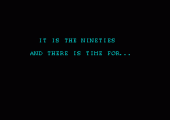
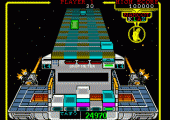
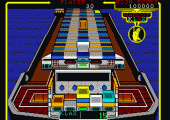
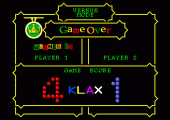
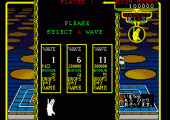
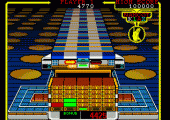
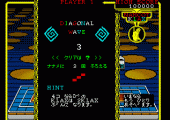
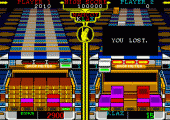

Recent Comments